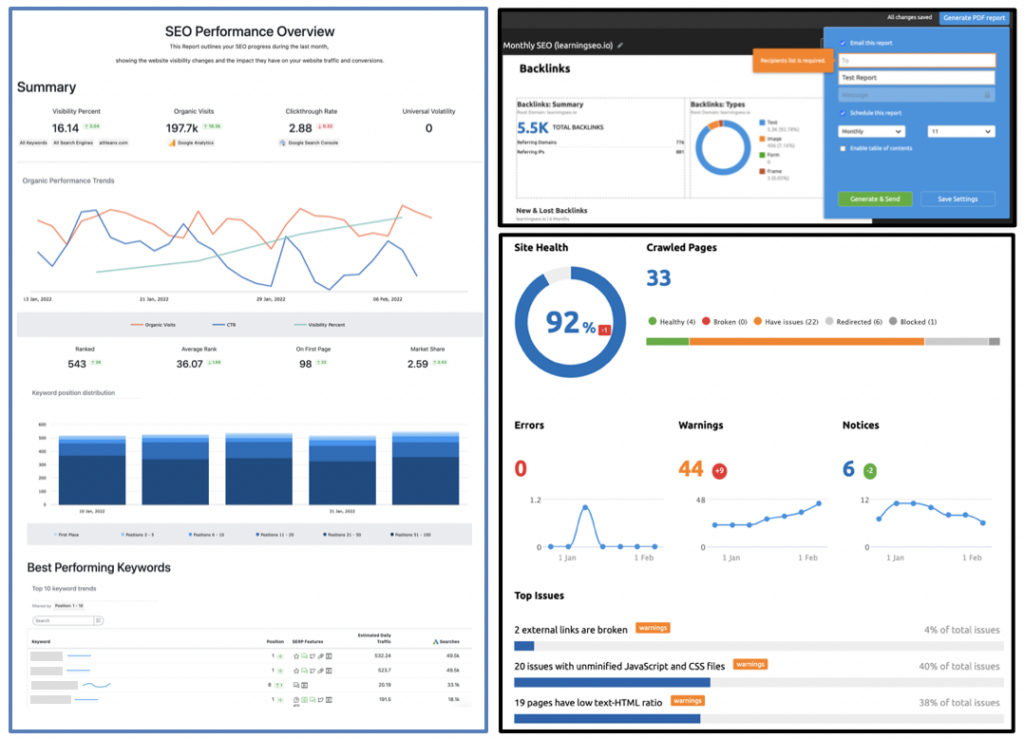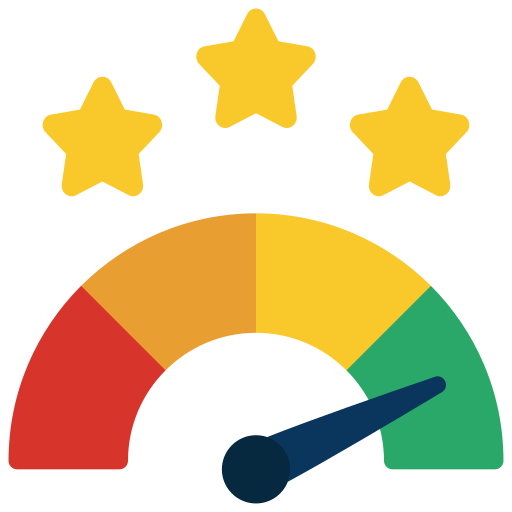Website Audit Services

What Is Website Audit Services ?
Website audit services involve the evaluation and analysis of a website’s performance, structure, and overall health in order to pinpoint areas that require improvement. This process encompasses a thorough review of multiple aspects of a website, including its design, content, user experience, search engine optimization (SEO), security, and performance.
When conducting a website audit, professionals assess the technical elements of the website, such as its loading speed, responsiveness, and compatibility across various devices and browsers. They also examine the on-page and off-page SEO factors of the website, including the usage of keywords, meta tags, backlinks, and the overall visibility on search engines.
Rating of website
Performing a comprehensive website audit to evaluate and rate the overall quality, performance, and effectiveness of a website.
Traffic analysis
Analyzing website traffic patterns and data to gain insights into visitor behavior, sources, and engagement levels.
Competitor analysis
Conducting a thorough analysis of competitors' websites to identify strengths, weaknesses, and opportunities for improvement in comparison.
SEO reports
Generating detailed reports on the website's search engine optimization (SEO) performance, including rankings, keywords, and recommendations for improvement.
Speed and performance report
Evaluating website speed and performance metrics, identifying bottlenecks, and providing recommendations to optimize loading times and user experience.


Rating of Website
When performing a website audit to evaluate its overall performance and effectiveness, there are several key factors to consider. Here are five important points to assess when rating a website:
Design and User Interface: Assess the overall design of the website, including its layout, color scheme, and visual appeal. Evaluate the user interface for its ease of use, intuitive navigation, and responsiveness across different devices.
Content Quality and Relevance: Examine the quality of the website’s content, including its relevance to the target audience and the purpose of the site. Look for well-written, informative, and engaging content that is up to date. Evaluate the use of multimedia elements such as images and videos.
Performance and Loading Speed: Evaluate the website’s performance in terms of loading speed and overall responsiveness. A fast-loading website enhances user experience and improves search engine rankings. Test the website on different devices and internet connections to ensure optimal performance.
Search Engine Optimization (SEO): Assess the website’s optimization for search engines. Look for proper usage of relevant keywords, meta tags, and well-structured URLs. Evaluate the presence of a sitemap, optimized heading tags, and internal linking to improve search engine visibility.
User Engagement and Conversion: Evaluate how well the website engages visitors and encourages them to take desired actions. Consider the presence of clear call-to-action buttons, contact forms, and conversion-oriented elements. Look for features that facilitate user interaction, such as social media integration and comment sections.
Traffic analysis
When conducting a traffic analysis as part of a website audit, you focus on evaluating the sources and patterns of website traffic. Here are five key points to consider during a traffic analysis:
Traffic Sources: Analyze website traffic sources: organic search, direct, referral, social media, paid advertising, and other relevant sources. Assess distribution for acquisition channels.
Traffic Volume: Evaluate website’s traffic volume: total visits, unique visitors, pageviews over specified time. Analyze trends, patterns, factors influencing traffic.
Examine user behavior metrics: bounce rate, time on site, pages per session, conversion rates. Identify areas for improvement based on high bounce rates, low engagement.
Analyze organic search keywords: identify top-ranking and assess relevance to website’s content and goals. Optimize existing or create new content targeting high-value keywords for increased organic traffic.
Geographic and Demographic Data: Utilize analytics tools to understand geographic and demographic data of website visitors. Identify primary countries, regions, cities, and analyze age, gender, interests to tailor marketing strategies and content.




Competitor analysis
When conducting a competitor analysis as part of a website audit, you’ll focus on evaluating the online presence and performance of your competitors. Here are five key points to consider when conducting a competitor analysis:
Website Design and User Experience: Analyze competitors’ website design, navigation, aesthetics, and user experience. Assess visuals, colors, typography to create an engaging user-friendly website.
Content Strategy and Quality: Evaluate competitors’ content strategy, type/format of content (blogs, videos), quality, relevance, SEO, keywords, and overall value of their content compared to yours.
SEO and Organic Search Performance: Analyze competitors’ SEO: keywords, meta tags, on-page optimization. Evaluate SERP ranking, backlinks, domain authority, and organic search performance compared to your website.
Social Media Presence and Engagement: Evaluate competitors’ social media presence: platforms, followers. Analyze content strategy, posting frequency, audience engagement (likes, comments, shares). Assess campaign effectiveness and audience connection.
Conversion Tactics and User Journey: Evaluate competitors’ conversion tactics: CTA placement, lead generation forms, user journey. Analyze sales funnel effectiveness and guiding visitors towards conversions. Consider incentives, offers, and actions that encourage user engagement.
SEO reports
When conducting an SEO audit and analyzing SEO reports for a website, you can focus on various factors that impact its search engine optimization. Here are five key points to consider when reviewing SEO reports:
Keyword Performance: Analyze keyword performance, rankings, organic traffic, conversions, competitiveness, and optimize keyword usage for website improvement.
Organic Traffic and Search Visibility: Review organic traffic and search visibility metrics. Assess total traffic volume, traffic patterns, search engine visibility, and keyword rankings. Analyze trends and SEO impact.
Backlink Profile and Authority: Evaluate backlink profile and domain authority. Assess quantity, quality, relevance, and diversity of backlinks. Analyze anchor text distribution. Identify link building opportunities.
On-Page Optimization: Review on-page optimization factors. Analyze title tags, meta descriptions, headers, keyword usage, density, URL structure, and internal linking. Identify improvements.
Technical SEO Analysis: Evaluate technical SEO aspects. Review crawlability, indexability, load speed, mobile-friendliness, XML sitemaps, and robots.txt. Identify technical issues impacting SEO.


Website Audit Services
Comprehensive Analysis
What Is Website Audit Services ?
Website audit services evaluate and analyze a website’s performance, structure, and overall health to identify areas for improvement. This comprehensive process reviews multiple aspects, including design, content, user experience, SEO, security, and performance. Professionals assess technical elements such as loading speed, responsiveness, and device/browser compatibility while examining on-page and off-page SEO factors like keyword usage, meta tags, backlinks, and search engine visibility.
Traffic analysis
When conducting a traffic analysis as part of a website audit, you focus on evaluating the sources and patterns of website traffic. Here are five key points to consider during a traffic analysis:
-
Traffic Sources: Analyze website traffic sources: organic search, direct, referral, social media, paid advertising, and other relevant sources. Assess distribution for acquisition channels.
-
Traffic Volume: Evaluate website’s traffic volume: total visits, unique visitors, pageviews over specified time. Analyze trends, patterns, factors influencing traffic.
-
Examine user behavior metrics: bounce rate, time on site, pages per session, conversion rates. Identify areas for improvement based on high bounce rates, low engagement.
-
Analyze organic search keywords: identify top-ranking and assess relevance to website’s content and goals. Optimize existing or create new content targeting high-value keywords for increased organic traffic.
-
Geographic and Demographic Data: Utilize analytics tools to understand geographic and demographic data of website visitors. Identify primary countries, regions, cities, and analyze age, gender, interests to tailor marketing strategies and content.


Rating of website
Performing a comprehensive website audit to evaluate and rate the overall quality, performance, and effectiveness of a website.

Content Quality Assessment
Reviewing the website’s content for relevance, accuracy, originality, and engagement, ensuring it aligns with audience expectations and business goal.

Traffic analysis
Analyzing website traffic patterns and data to gain insights into visitor behavior, sources, and engagement levels.

Competitor analysis
Conducting a thorough analysis of competitors’ websites to identify strengths, weaknesses, and opportunities for improvement in comparison.

SEO reports
Generating detailed reports on the website’s search engine optimization (SEO) performance, including rankings, keywords, and recommendations for improvement.

Speed and performance
Evaluating website speed and performance metrics, identifying bottlenecks, and providing recommendations to optimize loading times and user experience.

SEO reports
When conducting an SEO audit and analyzing SEO reports for a website, you can focus on various factors that impact its search engine optimization. Here are five key points to consider when reviewing SEO reports
-
Keyword Performance: Analyze keyword performance, rankings, organic traffic, conversions, competitiveness, and optimize keyword usage for website improvement.
-
Organic Traffic and Search Visibility: Review organic traffic and search visibility metrics. Assess total traffic volume, traffic patterns, search engine visibility, and keyword rankings. Analyze trends and SEO impact.
-
Backlink Profile and Authority: Evaluate backlink profile and domain authority. Assess quantity, quality, relevance, and diversity of backlinks. Analyze anchor text distribution. Identify link building opportunities.
-
On-Page Optimization: Review on-page optimization factors. Analyze title tags, meta descriptions, headers, keyword usage, density, URL structure, and internal linking. Identify improvements.
-
Technical SEO Analysis: Evaluate technical SEO aspects. Review crawlability, indexability, load speed, mobile-friendliness, XML sitemaps, and robots.txt. Identify technical issues impacting SEO.
Rating of Website
When performing a website audit to evaluate its overall performance and effectiveness, there are several
key factors to consider. Here are five important points to assess when rating a website:
Design and User Interface
Assess layout, color scheme, and responsiveness.
Content Quality and Relevance
Check for engaging, updated, relevant content.
Performance and Loading Speed
Evaluate speed and responsiveness on devices.
Search Engine Optimization (SEO)
Review keywords, meta tags, and structure.
User Engagement and Conversion
Ensure clear CTAs and interaction features.
Security and Data Protection
Verify SSL, encryption, and data safety.
Competitor analysis
When conducting a competitor analysis as part of a website audit, you’ll focus on evaluating the online presence and
performance of your competitors. Here are five key points to consider when conducting a competitor analysis:
01
Website Design & User Experience
Analyze competitors’ design, navigation, and aesthetics for user engagement.
02
Content Strategy and Quality
Evaluate competitors’ content relevance, SEO, and overall value.
03
SEO & Organic Search Performance
Assess competitors’ keywords, backlinks, and SERP ranking.
04
Social Media Presence & Engagement
Review competitors’ social platforms, engagement, and campaign effectiveness.
05
Conversion Tactics & User Journey
Analyze competitors’ CTAs, sales funnels, and user engagement strategies.
06
Performance & Speed Optimization
Evaluate competitors’ website loading speed and responsiveness.
Schedule a Meeting Today
Let us bring your vision to life with cutting-edge development. Contact us today and let’s turn your vision into reality

